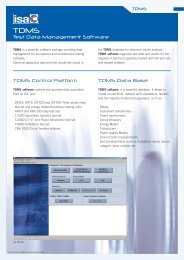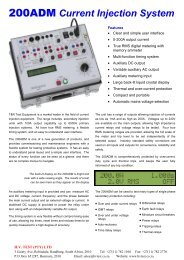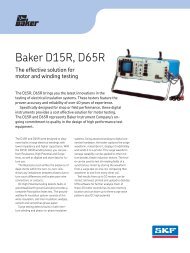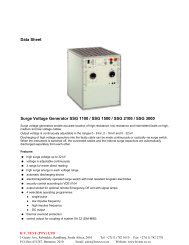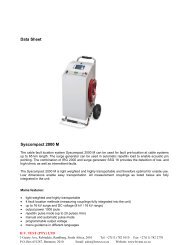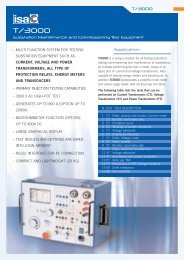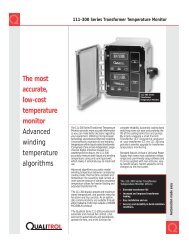POWER TRANSFORMER FREQUENCY RESPONSE ... - afra nojan
POWER TRANSFORMER FREQUENCY RESPONSE ... - afra nojan
POWER TRANSFORMER FREQUENCY RESPONSE ... - afra nojan
Create successful ePaper yourself
Turn your PDF publications into a flip-book with our unique Google optimized e-Paper software.
THEORETICAL BACKGROUND:<br />
The test is accomplished through the application<br />
and subsequent analysis of a series of low voltage<br />
impulses of varying duration, and approximately 300<br />
V magnitude. Based on the resulting current impulse<br />
measured by the current probe, the frequency response<br />
is calculated for frequencies up to 5 MHz. This<br />
technique is designed to detect winding shifts through<br />
non-destructive methods, and can either be used as a<br />
stand alone test to detect winding damage, or as a<br />
diagnostic tool to pinpoint damages discovered in other<br />
test results such as insulation power factor tests,<br />
dissolved gas analysis, or short circuit impedance.<br />
The testing software provided calculates objective<br />
estimates of the degree of movement based on two<br />
different patented analysis techniques, the Weighted<br />
Normalized Difference (WND) number is used in<br />
analysis of all types of transformers, and the Objective<br />
Winding Asymmetry (OWA) percentage, for use<br />
especially on three phase transformers and single phase<br />
identical sister units.<br />
Basic WND analysis allows comparison to<br />
previous FRA “fingerprints”, baseline data that may<br />
have been made on the transformer at the factory, or at<br />
an earlier date in the substation. This alone can be used<br />
as an effective technique to detect winding damages.<br />
The more advanced OWA technique has been<br />
developed especially for use in cases where no baseline<br />
data exists, but a condition assessment of the<br />
mechanical integrity of the windings is still required.<br />
This technique may be used very effectively in cases<br />
both with and without baseline data to detect and<br />
pinpoint damages to a specific phase and winding. This<br />
is accomplished through an objective (numerical)<br />
comparison of the three individual phase responses<br />
against each other, and a knowledge of the fact that<br />
while the individual phase responses of a three phase<br />
transformer are not identical, they should differ from<br />
each other in a predictable manner based on the<br />
symmetrical design and construction of the<br />
transformer.<br />
Even though the OWA test method has been<br />
shown to be very successful in locating mechanical<br />
winding shifts without historical data, development<br />
testing has shown that the most sensitive indicator of<br />
winding damage may result from the combination of<br />
the OWA test and the historical comparison.<br />
Comparison of a previous OWA test result to a present<br />
OWA test result on a given transformer provides a<br />
means of comparing differences in the frequency<br />
response records obtained from the same transformer<br />
at different times that is largely unaffected by variables<br />
such as temperature and oil condition, since changes<br />
in these parameters have a common influence on the<br />
phase-to-phase frequency response comparison.<br />
Extensive development testing has been done<br />
over a wide range of transformers in the power range<br />
of a several hundred kVA distribution transformers<br />
through several hundred MVA Class I, Class II<br />
substation and generator step up transformers to<br />
determine the evaluation criteria used in the PHENIX<br />
Technologies FRA-100 system. The OWA technology<br />
has been the only technology to date that has shown<br />
the ability to detect and locate problems on<br />
transformers even after they have been de-tanked, and<br />
have had their leads cut and bushings removed!<br />
Typical 3-Phase Transformer<br />
Transfer Function Plots with<br />
OWA Results Displayed







